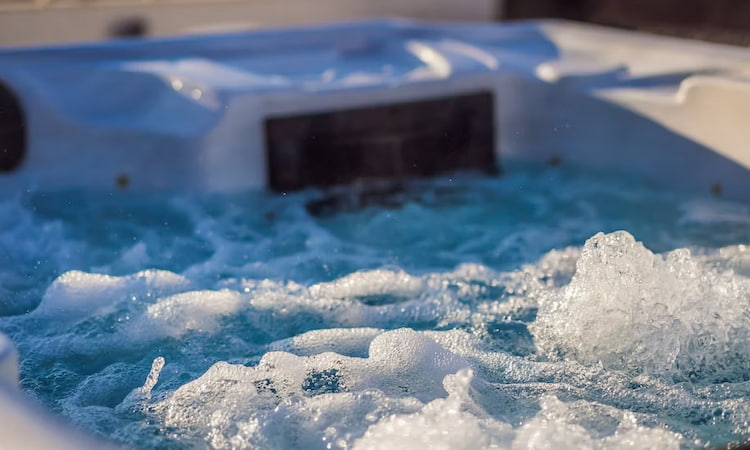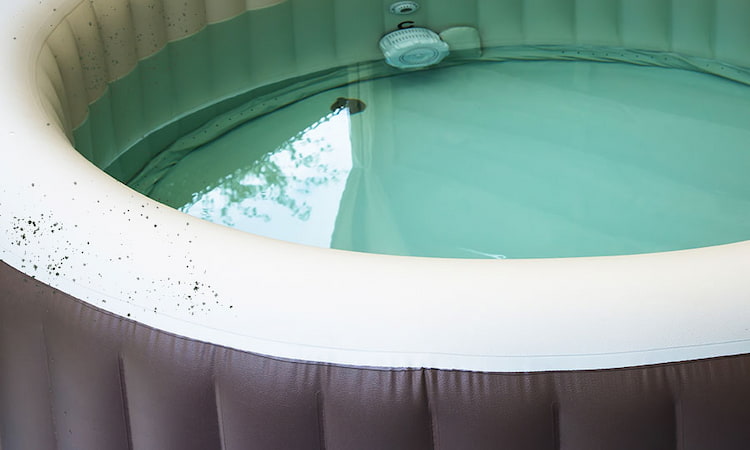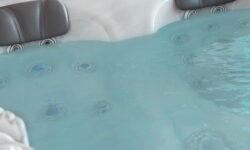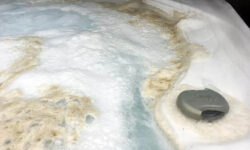You’ve noticed your hot tub’s surface feels gritty, and you’re wondering why. This is a common issue that can be caused by different factors.
Your hot tub might feel gritty due to the presence of excess minerals, such as calcium or magnesium, in the water. These minerals can lead to the formation of scale deposits, which feel like grit on the tub’s surface. Another possible reason could be an imbalance in the water’s pH level, leading to cloudiness and a gritty feel.
We’ll provide effective cleaning methods and troubleshooting tips to help you restore and maintain your tub’s smoothness. So, let’s get your hot tub back to the relaxing oasis it’s meant to be.

Quick Navigation
Understanding the Causes of a Gritty Hot Tub
You’ve got to understand that water-quality issues are often the root cause of a gritty hot tub. This grit can come from various sources such as minerals, algae, or even bacteria. When these substances accumulate, they can create an abrasive layer at the bottom of your hot tub, leading to a gritty feel underfoot.
First off, hard water is a primary culprit. High levels of calcium or magnesium can cause scale deposits, which feel like grit. You’ll need to regularly test and adjust your water hardness to prevent this.
Next, poor filtration can lead to a build-up of debris in your hot tub. A faulty or clogged filter won’t effectively remove particles, allowing them to settle and create a gritty texture.
Lastly, consider algae and bacteria. Without proper sanitization, these microorganisms can proliferate, leading to biofilm formation. This slimy layer can break off into tiny particles, adding to the gritty sensation.
The Role of Water Chemistry in Hot Tub Grittiness
A significant part of maintaining your hot tub’s smoothness is understanding the crucial role water chemistry plays in preventing or causing that unpleasant gritty feel. When your tub’s water chemistry is unbalanced, it can lead to a range of issues, including the formation of scale deposits that can make the tub feel gritty.
Water balance involves maintaining the right levels of pH, alkalinity, and calcium hardness. When the pH level is too high, for instance, it can lead to scale build-up. Similarly, low pH can result in corrosive water, capable of eating away at your hot tub’s surface and creating a gritty texture.
It’s also crucial to monitor the levels of calcium hardness. If the calcium level is too high, it can lead to the formation of calcium deposits, contributing to the gritty feel. Conversely, low calcium hardness can result in corrosive water conditions.
The Impact of Algae on Hot Tub Surfaces

If there’s ever a substantial amount of algae growth on your hot tub surfaces, you’ll likely notice an unpleasant gritty feel. This is because algae colonies, while microscopic individually, can multiply rapidly and form a slimy layer on your tub’s surfaces. This layer, when touched, can feel gritty.
This can significantly impact your hot tub experience in multiple ways:
- Aesthetic Impact: The greenish or brownish hue of algae can leave your hot tub looking unsightly and uninviting.
- Physical Discomfort: The gritty texture of the algae can be uncomfortable to sit or step on.
- Health Risk: Certain types of algae can cause skin irritations or even infections.
- Equipment Damage: Algae can clog filters and other components, potentially leading to costly repairs or replacements.
To avoid these issues, it’s crucial to maintain proper water chemistry and cleanliness. Regular checks and adjustments of the water’s pH and sanitizer levels, thorough cleaning of the tub’s surfaces, and use of algaecides can help keep algae at bay. With a little diligence, you can keep your hot tub inviting, comfortable, and safe.
Methods for Cleaning and Maintaining a Smooth Hot Tub
Keeping your hot tub free from grit involves regular maintenance and effective cleaning techniques. You need to perform routine checks and cleanings to ensure the tub’s surface remains smooth and inviting.
Here are some useful tips:
| Cleaning Method | Benefit |
|---|---|
| Regular Scrubbing | Creates a sense of accomplishment. Scrubbing your hot tub regularly maintains its cleanliness and saves you from larger, more tedious tasks. |
| Use of Specific Cleaning Agents | Provides peace of mind. Knowing that you’re using products designed for hot tub surfaces ensures no harm comes to your tub. |
| Routine Water Replacement | Makes you feel responsible. Changing the water regularly helps prevent the build-up of grit and other impurities. |
| Scheduled Professional Servicing | Gives you a feeling of assurance. Having professionals check your tub means it’s in capable hands, reducing your worry. |
Here is a complete blog post on how to fix the sandpaper feel in your hot tub.
Troubleshooting Tips for Persistent Hot Tub Grittiness
Despite your best efforts, you might still encounter stubborn grittiness in your hot tub. But don’t despair, there are a few troubleshooting tips you can try to resolve this issue.
- Examine the water chemistry: If your hot tub’s water chemistry is off balance, it could result in grittiness. You’ll need to test the pH, alkalinity, and calcium hardness levels. These should be 7.4-7.6, 80-120 ppm, and 150-250 ppm respectively.
- Check the filtration system: In case of a faulty or dirty filter, it might not effectively remove all debris, leading to a gritty feeling. Regular cleaning or replacement is crucial.
- Inspect the hot tub shell: The problem might not be the water. The hot tub surface might be deteriorating. If that’s so, you’ll need professional help.
- Consider getting a hot tub vacuum: These devices are great for removing debris that could be causing the gritty sensation.
Frequently Asked Questions
A gritty hot tub could expose you to harmful bacteria, potentially causing skin and eye infections. It’s crucial you regularly clean and maintain your tub to avoid these health risks. Don’t neglect your hot tub’s hygiene.
Yes, a gritty hot tub can damage your swimwear. The abrasive particles may cause pilling, fading, or wear in the fabric over time. It’s best to clean and balance your tub’s water to prevent this issue.
You should replace your hot tub’s water every three to four months. Regular replacement helps prevent the buildup of grit, ensuring a clean, enjoyable soak. Don’t forget to clean the tub and filter as well.
Yes, using a hot tub cover can help. It’ll prevent debris from entering the water, which can cause grittiness. However, you’ll still need to regularly clean and maintain your tub for the best results.
Yes, certain materials can be more prone to grittiness. It’s often due to scale formation from hard water. Acrylic tubs may resist this better than fiberglass. Regular maintenance helps prevent this gritty feeling.
Conclusion
In conclusion, a gritty hot tub can result from a variety of issues, including improper water chemistry, algae buildup, or poor maintenance.
Regular cleaning and careful monitoring of your water’s pH levels can help maintain a smooth, enjoyable hot tub experience. If grittiness persists, consider seeking professional assistance.
Remember, taking care of your hot tub is an important part of ensuring its longevity and your relaxation.



![What Causes Foaming in a Hot Tub? [& What to do] what causes foaming in a hot tub](https://hottubtales.com/wp-content/uploads/2022/12/what-causes-foaming-in-a-hot-tub.jpg)

![Is Yellow Hot Tub Water Safe? [& Treatment Options] is yellow water in hot tub safe](https://hottubtales.com/wp-content/uploads/2023/10/is-yellow-water-in-hot-tub-safe-250x150.jpg)
